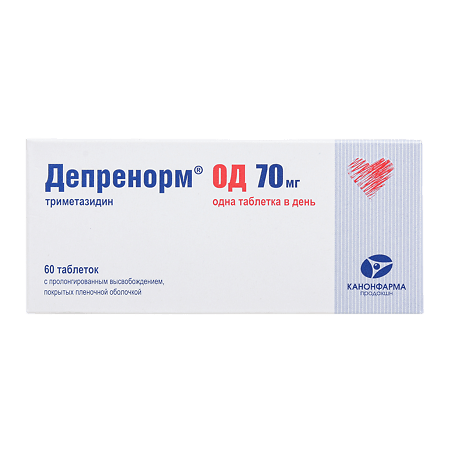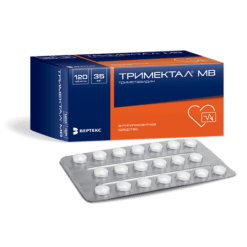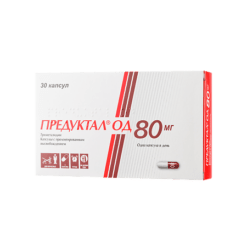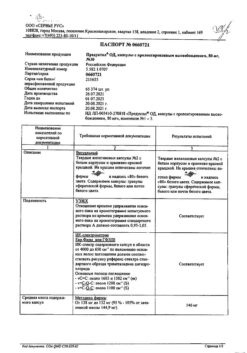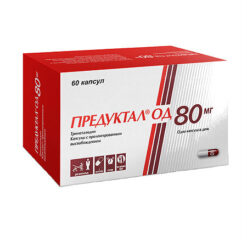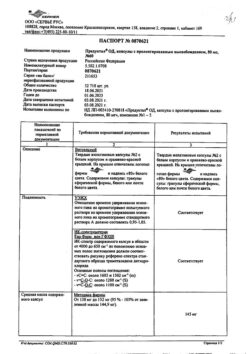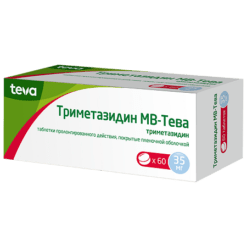No products in the cart.
Deprenorm OD, 70 mg 60 pcs
€24.39 €20.33
Description
Pharmacodynamics
Trimetazidine prevents intracellular reduction of adenosine triphosphatase (ATP) activity under ischemia and hypoxia, preserving energy metabolism and ensuring cell homeostasis by ensuring normal functioning of cell membrane ion channels and transmembrane sodium-potassium flow.
It inhibits beta-oxidation of fatty acids by selectively blocking the enzyme 3-ketoacyl-CoA-thiolase, which enhances glucose oxidation.
The cells in ischemia require less oxygen for energy during glucose oxidation than during beta-oxidation of fatty acids.
The switch of cellular energy metabolism from fatty acid oxidation to glucose oxidation underlies the pharmacological effects of trimetazidine. Under experimental conditions it has been shown that the drug:
-supports energy metabolism of the heart and neurosensory tissues under ischemia;
-reduces the severity of intracellular acidosis and changes in transmembrane ion flow occurring during ischemia;
-reduces migration and infiltration of polynuclear neutrophils in ischemic and reperfused heart tissues;
-reduces the size of myocardial damage;
-does not have adverse effects on hemodynamic parameters.
In patients with coronary heart disease, trimetazidine acts as a metabolic agent, maintaining sufficient intracellular high-energy phosphate activity in the myocardium. The anti-ischemic effect is achieved without affecting hemodynamics.
In patients with angina pectoris, trimetazidine:
-increases coronary reserve, thereby delaying the onset of exercise-induced ischemia beginning on day 15 of therapy;
Limits exercise-induced blood pressure fluctuations without significant changes in heart rate;
-reduces the frequency of angina attacks and the need to take short-acting nitroglycerin;
-improves left ventricular contractile function in patients with ischemic dysfunction.
Pharmacokinetics
In oral administration, trimetazidine is rapidly absorbed from the gastrointestinal tract (GIT), with maximum plasma concentration reached in an average of 5 hours. For more than 24 hours, the plasma concentration of trimetazidine is maintained at levels greater than or equal to 75% of maximum.
The equilibrium state of the drug concentration in blood is reached after 60 hours. Food intake has no effect on the pharmacokinetic properties of trimetazidine. The volume of distribution is 4.8 l/kg. The binding to plasma proteins is low and in vitro is 16%.
Trimetazidine is excreted mainly by the kidneys, mainly unchanged. When administered orally at a dose of 35 mg, the elimination half-life is on average 7 hours in young healthy volunteers and 12 hours in patients older than 65 years.
The total renal clearance of trimetazidine directly correlates with creatinine clearance (CK), hepatic clearance decreases with age.
Patients older than 75 years
In patients older than 75 years, an increase in plasma exposure to trimetazidine may be observed as a result of age-related decline in renal function. No differences have been found regarding the safety of the drug in patients over 75 years of age compared to the general population.
Patients with impaired renal function
Trimetazidine plasma exposure was increased approximately 2.4-fold in patients with moderate renal impairment (CKD 30-60 ml/min) and approximately 4-fold in patients with severe renal impairment (CKD less than 30 ml/min) compared with healthy volunteers with normal renal function.
No differences were found regarding the safety of the drug in patients with impaired renal function compared to the general population.
The use in children and adolescents
The pharmacokinetics of trimetazidine in children and adolescents younger than 18 years has not been studied.
Indications
Indications
Long-term therapy of coronary heart disease: prevention of attacks of stable angina as part of mono- or combination therapy.
Pharmacological effect
Pharmacological effect
Pharmacodynamics
Trimetazidine, under conditions of ischemia and hypoxia, prevents the intracellular decrease in adenosine triphosphatase (ATP) activity, preserving energy metabolism and ensuring cell homeostasis by ensuring the normal functioning of ion channels of cell membranes and transmembrane sodium-potassium flow.
It inhibits beta-oxidation of fatty acids by selectively blocking the enzyme 3-ketoacyl-CoA thiolase, which enhances glucose oxidation.
Cells in a state of ischemia require less oxygen to obtain energy from glucose oxidation than from beta-oxidation of fatty acids.
The switching of cellular energy metabolism from fatty acid oxidation to glucose oxidation underlies the pharmacological effects of trimetazidine. Under experimental conditions it has been shown that the drug:
– supports the energy metabolism of the heart and neurosensory tissues under ischemic conditions;
-reduces the severity of intracellular acidosis and changes in the transmembrane ion flow that occur during ischemia;
-reduces the migration and infiltration of polynuclear neutrophils in ischemic and reperfused cardiac tissues;
-reduces the size of myocardial damage;
-does not have an adverse effect on hemodynamic parameters.
In patients with coronary heart disease, trimetazidine acts as a metabolic agent, maintaining sufficient intracellular activity of high-energy phosphates in the myocardium. The anti-ischemic effect is achieved without affecting hemodynamics.
In patients with angina, trimetazidine:
-increases coronary reserve, thereby slowing down the onset of ischemia caused by physical activity, starting from the 15th day of therapy;
– limits fluctuations in blood pressure caused by physical activity, without significant changes in heart rate;
-reduces the frequency of angina attacks and the need for
taking short-acting nitroglycerin;
– improves contractile function of the left ventricle in patients with ischemic dysfunction.
Pharmacokinetics
When taken orally, trimetazidine is rapidly absorbed from the gastrointestinal tract (GIT), its maximum concentration in blood plasma is achieved on average within 5 hours. For more than 24 hours, trimetazidine plasma concentrations are maintained at levels greater than or equal to 75% of the maximum.
The equilibrium state of drug concentration in the blood is achieved after 60 hours. Food intake does not affect the pharmacokinetic properties of trimetazidine. The volume of distribution is 4.8 l/kg. The binding to plasma proteins is low and in vitro is 16%.
Trimetazidine is excreted mainly by the kidneys, mainly unchanged. When taken orally at a dose of 35 mg, the half-life in young healthy volunteers averages 7 hours, in patients over 65 years of age – 12 hours.
Total renal clearance of trimetazidine directly correlates with creatinine clearance (CC), and hepatic clearance decreases with age.
Patients over 75 years of age
In patients over 75 years of age, increased plasma exposure of trimetazidine may occur as a result of age-related decreases in renal function. No differences were found regarding the safety of the drug in patients over 75 years of age compared to the general population.
Patients with impaired renal function
Plasma exposure of trimetazidine was increased approximately 2.4-fold in patients with moderate renal impairment (creatinine clearance 30-60 ml/min), and approximately 4-fold in patients with severe renal impairment (creatinine clearance less than 30 ml/min) compared with healthy volunteers with normal renal function.
No differences were found regarding the safety of the drug in patients with impaired renal function compared to the general population.
Use in children and adolescents
The pharmacokinetics of trimetazidine in children and adolescents under 18 years of age have not been studied.
Special instructions
Special instructions
Trimetazidine is not intended for the relief of angina attacks and is not indicated for the initial course of treatment of unstable angina or myocardial infarction in the prehospital stage or in the first days after the patient’s hospitalization.
If an attack of angina occurs, treatment (drug therapy or revascularization procedure) should be reviewed and adapted.
Trimetazidine can cause or worsen symptoms of parkinsonism (tremor, akinesia, increased muscle tone), so careful medical supervision is required in such patients, especially the elderly. In doubtful cases, patients should be referred to a neurologist for appropriate examination.
If movement disorders occur, such as symptoms
Parkinsonism, restless legs syndrome, tremor, instability in the Romberg position and unsteadiness of gait, trimetazidine should be discontinued. Such cases are rare and symptoms usually resolve after discontinuation of therapy (in most patients within 4 months after discontinuation of the drug).
If symptoms of parkinsonism persist for more than 4 months after stopping the drug, consultation with a neurologist is necessary. Falls may occur due to unsteadiness in the Romberg position and unsteadiness of gait or a marked decrease in blood pressure, especially in patients taking antihypertensive drugs.
Careful medical supervision is required when using trimetazidine in patients with severe hepatic impairment and in patients over 75 years of age (due to a possible increase in its exposure due to age-related decline in renal function).
Impact on the ability to drive vehicles and machinery
Due to the possible development of dizziness and other undesirable reactions while taking the drug, caution should be exercised when driving vehicles and machinery, as well as engaging in other activities that require increased concentration and speed of psychomotor reactions.
Active ingredient
Active ingredient
Trimetazidine
Composition
Composition
1 extended-release film-coated tablet contains:
active ingredient: trimetazidine dihydrochloride 70.00 mg;
excipients: hypromellose (hydroxypropyl methylcellulose) 171.00 mg; carbomer 10.97 mg; colloidal silicon dioxide 6.00 mg; magnesium stearate 3.00 mg; microcrystalline cellulose 189.03 mg;
composition of the film shell: Opadry transparent 2.60 mg, including: hypromellose (hydroxypropyl methylcellulose) 2.08 mg; macrogol-4000 (polyethylene glycol-4000) 0.52 mg;
Opadry II pink 12.40 mg, including: sunset yellow dye 0.3150 mg; crimson dye [Ponceau 4R] 0.2579 mg; indigo carmine dye 0.1798 mg; polyvinyl alcohol 4.9600 mg; macrogol-4000 (polyethylene glycol-4000) 2.5048 mg; talc 1.8352 mg, titanium dioxide 2.3473 mg.
Pregnancy
Pregnancy
The use of trimetazidine during pregnancy is contraindicated. There are no clinical data on experience with the use of trimetazidine in pregnant women.
Animal studies have not revealed the presence of teratogenic effects. The potential risk of using trimetazidine during pregnancy in humans is unknown. It is unknown whether trimetazidine or its metabolites passes into breast milk.
The use of trimetazidine during breastfeeding is contraindicated. If it is necessary to use the drug Deprenorm® OD, breastfeeding should be stopped.
Contraindications
Contraindications
Hypersensitivity to trimetazidine or any of the excipients of the drug;
Parkinson’s disease, symptoms of parkinsonism, tremor, restless legs syndrome and other associated movement disorders;
moderate to severe renal failure (creatinine clearance (CC) less than 60 ml/min);
pregnancy;
breastfeeding period;
age under 18 years (there are no data on the effectiveness and safety of trimetazidine in this age category).
With caution:
In patients with severe hepatic impairment and patients over the age of 75 years (due to possible increased exposure to trimetazidine).
Side Effects
Side Effects
To assess the frequency of adverse reactions, the following criteria were used: very often (≥1/10); often (≥1/100, ≤1/10); uncommon (≥1/1000, ≤1/100); rare (≥1/10000, ≤1/1000); very rare (≤1/10000), frequency unknown – it is not possible to estimate the frequency based on the available data.
Blood and lymphatic system disorders
Frequency unknown: agranulocytosis, thrombocytopenia, thrombocytopenic purpura.
Nervous system disorders
Common: dizziness, headache;
Frequency unknown: symptoms of parkinsonism (tremor, akinesia, increased muscle tone), instability in the Romberg position and unsteadiness of gait, restless legs syndrome, other associated movement disorders, usually reversible after cessation of therapy), sleep disorders (insomnia, drowsiness).
Hearing and labyrinth disorders
Frequency unknown: vertigo.
Heart disorders
Rarely: palpitations, extrasystole, tachycardia.
Vascular disorders
Rarely: decreased blood pressure, orthostatic hypotension (may be accompanied by general weakness, dizziness or loss of balance, especially when taking antihypertensive drugs simultaneously, flushing of the face.
Gastrointestinal disorders
Common: abdominal pain, diarrhea, dyspepsia, nausea, vomiting;
Frequency unknown: constipation.
Disorders of the liver and biliary tract
Frequency unknown: hepatitis.
Skin and subcutaneous tissue disorders
Common: skin rash, itching, urticaria;
Frequency unknown: acute generalized exanthematous pustulosis, Quincke’s edema.
General and administration site disorders
Often: asthenia.
Interaction
Interaction
Cases of drug interactions have not been described.
Overdose
Overdose
There is limited information about trimetazidine overdose. In case of overdose, symptomatic therapy should be carried out.
Storage conditions
Storage conditions
At a temperature not exceeding 25 C in secondary packaging (cardboard pack). Keep out of the reach of children.
Shelf life
Shelf life
3 years.
Manufacturer
Manufacturer
Kanonpharma production CJSC, Russia
Additional information
| Shelf life | 3 years. |
|---|---|
| Conditions of storage | At a temperature not exceeding 25 C in a secondary package (carton pack). Keep out of reach of children. |
| Manufacturer | Kanonfarma Production ZAO, Russia |
| Medication form | sustained release tablets |
| Brand | Kanonfarma Production ZAO |
Other forms…
Related products
Buy Deprenorm OD, 70 mg 60 pcs with delivery to USA, UK, Europe and over 120 other countries.

